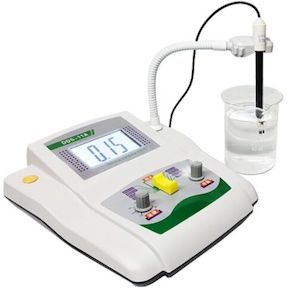
-----
TDS vs PPM vs. µS?
Q. I think tds is the temperature of your water,
and ppm is the weight of your water.
If I am wrong than what is the right answer -- please give me suggestion.
- New delhi
October 13, 2022
A. Hi Saif. PPM means 'parts per million' and, although it is usually used to describe water quality, it is actually a mathematical term that could refer to anything. For example, if there are 25,000,000 people in Delhi, and 50 of them take the #1 bus at 7:00 AM, then 50 people per 25,000,000 take the 7.00 AM #1 bus, or 2 PPM.
A liter holds 1,000 grams of water, and a gram is 1,000 milligrams, so there are 1,000,000 milligrams in a liter ... which means that PPM and mg/l are equivalent and are often used interchangeably.
TDS means 'total dissolved solids' and is a measure of the concentration of some other substance dissolved in the water. For example, sea water contains about 35 grams of salt per liter, or 35,000 mg/l or 35,000 PPM. If there is nothing in the sea water other than those 35 grams of salt, then the TDS equals 35,000 PPM.
Luck & Regards,

Ted Mooney, P.E. RET
Striving to live Aloha
finishing.com - Pine Beach, New Jersey
Ted is available for instant help
or longer-term assistance.
⇩ Related postings, oldest first ⇩
TDS = total dissolved solids
PPM = parts per million
µS = microSiemens
mg/l = milligram per liter
EC = electrical conductivity
CF = conductivity factor mS = milliSiemens cm = centimeter
Q. Hi, kindly advise if TDS and PPM have any relation.
Also is it correct that 200 TDS is equal to 200 PPM
And shall I use 200 TDS water for the purpose of 200 PPM.
REGARDS,
RO PLANT - RAK, UAE
February 24, 2009
A. There is a lot of confusion regarding TDS measurement, particularly if you have a meter that reads in mg/L of TDS.
Meters that read in TDS are actually conductivity meters. For neutral pH tap water, the relationship is very close to 1 mg/L of TDS = 1.6 micro-Siemens. The more unusual your water analysis is and the further away it is from a pH of 7.0, the less accurate this relationship is, and the true TDS may be significantly higher or lower than the meter reads.
A true TDS measurement requires evaporating a filtered sample to dryness and weighing the residue.
consultant - Cleveland Heights, Ohio
A. The meaning of all this would be that your TDS meter is reading (in this example) 200 Parts Per Million of Total Dissolved Solids. The two terms are not interchangeable.

Sheldon Taylor
supply chain electronics
Wake Forest, North Carolina
Q. How to convert microsiemens to ppm (parts per million)?
Thanks. Best regards,
Mamu Mvh- Indonesia
May 14, 2009
by American Water Works Association

on eBay or Amazon
or AbeBooks
(affil link)
A. There are three conversion factors which various manufacturers use for displaying ppm's...
European: 1 mS/cm (EC 1.0 or CF 10) = 640 ppm
Australian: 1 mS/cm (EC 1.0 or CF 10) = 700 ppm
Eutech: 1 mS/cm (EC 1.0 or CF 10) = 640 ppm
Truncheon: 1 mS/cm (EC 1.0 or CF 10) = 700 ppm
If your meter allows you to switch between EC and TDS units, your conversion factor can be easily determined by dividing one by the other.
Place the probe in the solution and read TDS in ppm. Change to EC on the meter and read EC in mS/cm.
Conversion factor = ppm / EC.
[Note: mS must be converted to use: One milliSiemen = 1000 microSiemens (1.0 mS/cm = 1000.0 µS/cm)
According to the chart below:
1000 uµS/cm = 500 ppm
Conversion factor = ppm / (mS/cm * 1000)
.50 = 500ppm / (1000µS/cm) ]
The answer is your meter's conversion factor and should be a number between 0.50 and 0.72. To improve accuracy, take EC and ppm readings from your res daily for about ten days. Average the conversion factors. The more data points that you use, the closer you will be to finding your true conversion factor.
When reporting your PPM in a thread, please give the conversion factor your meter uses. For example: 550 PPM @0.7 or give the reading in EC, which should be the same meter to meter.
- DELHI, INDIA
-- this entry appended to this thread by editor in lieu of spawning a duplicative thread
Q. Is there a different scale for measuring ppm with a TDS meter and a PPM meter? Someone told me you must convert the reading in ppm from my TDS meter to correlate with his ppm meter. My TDS meter at 500 ppm would be approximately 700 ppm on his meter. Please help with this question.
Thanks,
Harry
- El Rito, New Mexico, USA
June 14, 2012
A. Hi Harry. We added your question to a thread where Nitin Peter seems to have answered it well. But please get back to us if it's not clear.
Luck & Regards,

Ted Mooney, P.E.
Striving to live Aloha
finishing.com - Pine Beach, New Jersey
Ted is available for instant help
or longer-term assistance.
Q, A, or Comment on THIS thread -or- Start a NEW Thread
